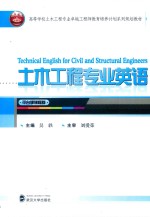图书介绍
土木工程专业英语pdf电子书版本下载

- 吴轶主编 著
- 出版社: 武汉:武汉大学出版社
- ISBN:9787307159952
- 出版时间:2015
- 标注页数:163页
- 文件大小:26MB
- 文件页数:176页
- 主题词:土木工程-英语-高等学校-教材
PDF下载
下载说明
土木工程专业英语PDF格式电子书版下载
下载的文件为RAR压缩包。需要使用解压软件进行解压得到PDF格式图书。建议使用BT下载工具Free Download Manager进行下载,简称FDM(免费,没有广告,支持多平台)。本站资源全部打包为BT种子。所以需要使用专业的BT下载软件进行下载。如 BitComet qBittorrent uTorrent等BT下载工具。迅雷目前由于本站不是热门资源。不推荐使用!后期资源热门了。安装了迅雷也可以迅雷进行下载!
(文件页数 要大于 标注页数,上中下等多册电子书除外)
注意:本站所有压缩包均有解压码: 点击下载压缩包解压工具
图书目录
Chapter 1 Overview of Civil Engineering 1
1.1 Introduction of Civil Engineering 1
Section A The Origin of Civil Engineering 1
Section B What Is a Civil Engineer 3
1.2 The Importance of Civil Engineering 5
Section A The Role of Civil Engineering in Society 5
Section B Historic Civil Engineering Landmarks 6
References 9
Chapter 2 Types of Civil Engineering 11
2.1 Structural Engineering 11
Section A Introduction of Structural Engineering 11
Section B Basic Types of Structures 13
2.2 Bridge Engineering 15
2.3 Underground Engineering 17
Section A Introduction of Metropolitan Railway 17
Section B Introduction of Tunnel Engineering 18
2.4 Road Engineering 20
Section A Introduction of Road Engineering 20
Section B Maintenance of Road Engineering 22
References 24
Chapter 3 Materials of Civil Engineering 26
3.1 Concrete 26
Section A Introduction of Concrete 26
Section B Properties of Concrete 27
3.2 Steel 29
3.3 Masonry 30
References 31
Chapter 4 Loads and Actions in Civil Engineering 32
4.1 Dead Load and Live Load 32
4.2 Wind Load and Wind Damage 33
Section A Introduction of Wind Load 33
Section B Classification of Wind Load 34
Section C Horizontal Wind Loads and Roof Wind Loads on Structural Frames 35
Section D Wind for Components and Wind Damage 36
4.3 Earthquake Action and Damage 38
Section A Earthquake Action 38
Section B Earthquake Damage 39
4.4 Tsunami Damage to the Structure of Civil Engineering 41
Section A Tsunami Damage 41
Section B Tsunami Damage to Buildings 43
Section C Resistance of Tsunamis for Structures 44
References 45
Chapter 5 Members of Civil Engineering 46
5.1 Horizontal Forced Structural Members 46
Section A Introduction of Beam 46
Section B Forces within a Beam 48
Section C Shear Strength and Parameters 50
Section D Coupling Beams 52
Section E Flat Plates 54
Section F Behavior of Concrete Slabs 56
Section G Floor Framing Systems 57
5.2 Vertical Forced Structural Members 59
Section A Introduction of Column 59
Section B Increasing Compressive Strength 60
Section C High-strength Steel in Concrete Columns 62
Section D Confinement in Reinforced Concrete Columns 63
Section E Introduction of Concrete Structural Wall 65
Section F Behavior of Structural Wall 67
Section G Steel Plate Shear Walls 69
5.3 Arch 70
Section A Introduction of Arches 70
Section B Development of Arch Bridges 71
5.4 Truss 74
Section A Introduction of Truss 74
Section B Analysis of Internal Force 75
Section C Production and Installation of a Truss 77
References 78
Chapter 6 Basic Types of Engineering Structure 82
6.1 Reinforced Concrete Structures 82
Section A Application of Reinforced Concrete Structures 82
Section B Performance of Reinforced Concrete Structures 83
6.2 Steel Structure 85
Section A Introduction of Steel Structures 85
Section B Incheon International Airport 87
6.3 Classification of Steel Concrete Composite Structure 88
Section A Steel Concrete Composite Structure 88
Section B Concrete-filled Steel Tube Column 89
6.4 The Modern Complex High-rise Building Structure 90
Section A Performance-based Seismic Design 90
Section B Performance Objectives of PBSD 92
References 93
Chapter 7 Bridge Engineering 95
7.1 Introduction of Bridge Engineering 95
Section A History of Bridge 95
Section B London Millennium Footbridge 96
7.2 Classification of Bridge 98
Section A Rigid Beam and Cantilever 98
Section B Suspension and Arch 99
7.3 Design of Bridge 100
Section A Design of Bridge Structure 100
Section B Numerical Analysis of Bridge Structures 101
References 102
Chapter 8 Underground Engineering 104
8.1 Introduction of Underground Engineering 104
Section A Exploitation of Underground Space 104
Section B The Underground Strategy 105
8.2 Underground Tunnel Engineering 106
Section A Tunneling Risk 106
Section B A New Requirement of Tunneling 107
8.3 Development of Underground Space Structure 108
Section A Web-based Shield Tunnel Construction Information System 108
Section B Urban Underground Space Planning 110
References 111
Chapter 9 Road Engineering 114
9.1 Urban Road 114
Section A Introduction of Urban Road 114
Section B Development of Road Engineering 115
9.2 Freeway Engineering 117
Section A Design of Freeway 117
Section B Development of Freeway 118
References 119
Chapter 10 Foundation Engineering 122
10.1 Introduction of Foundation 122
Section A A Shallow Foundation 122
Section B Types of Pile Foundation 124
10.2 The Principles of Foundation Design 126
Section A What Is Foundation Design 126
Section B Causes of Settlement 127
References 128
Chapter 11 Performance-based Seismic Design 129
11.1 Introduction of Performance-based Seismic Design 129
Section A The Origin of Performance-based Seismic Design 129
Section B Development of Performance-based Seismic Design 130
11.2 Structural Seismic Demand and Seismic Capacity 132
Section A Structural Seismic Demand 132
Section B Structural Seismic Capacity 133
11.3 Loss Evaluation in Earthquake Events 135
Section A Methodologies of Earthquake Economic Loss Estimate 135
Section B Earthquake Disaster 136
References 137
Chapter 12 Isolation and Energy Dissipation Damper Technology 141
12.1 Seismic Isolation Technology 141
Section A Introduction of Seismic Isolation Technology 141
Section B Functions of Seismic Isolation Technology 143
12.2 Energy Dissipation System 144
Section A Introduction of Energy Dissipation System 144
Section B Classification of Dampers 146
References 148
Chapter 13 Retrofitting Techniques for Seismic Strengthening 150
13.1 Outline of Retrofitting Techniques for Seismic Strengthening 150
Section A Origin of Retrofitting Techniques for Seismic Strengthening 150
Section B The Importance of Retrofitting Techniques for Seismic Strengthening 151
Section C Problems of Retrofitting Techniques for Seismic Strengthening 153
13.2 Types of Retrofitting Techniques for Seismic Strengthening 155
Section A Classification of Retrofitting Techniques for Seismic Strengthening 155
Section B Introduction of Fibre Reinforced Polymer 157
13.3 Applications of Materials in Seismic Strengthening 159
Section A Applications of Composite Materials 159
Section B Steel Plates in Seismic Strengthening 161
References 162